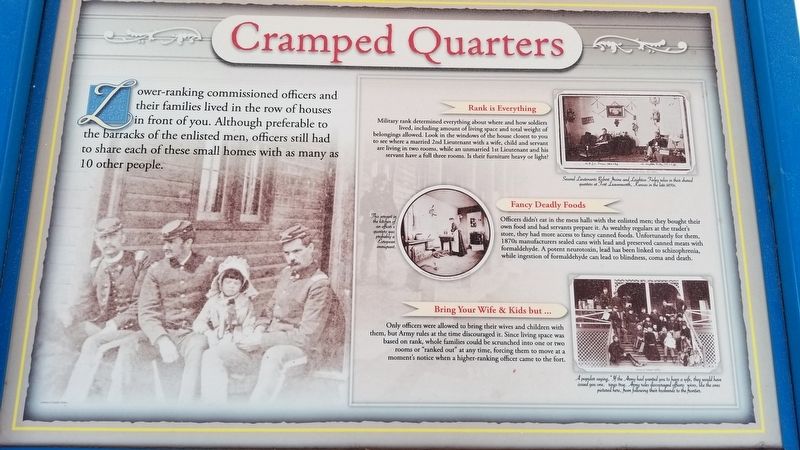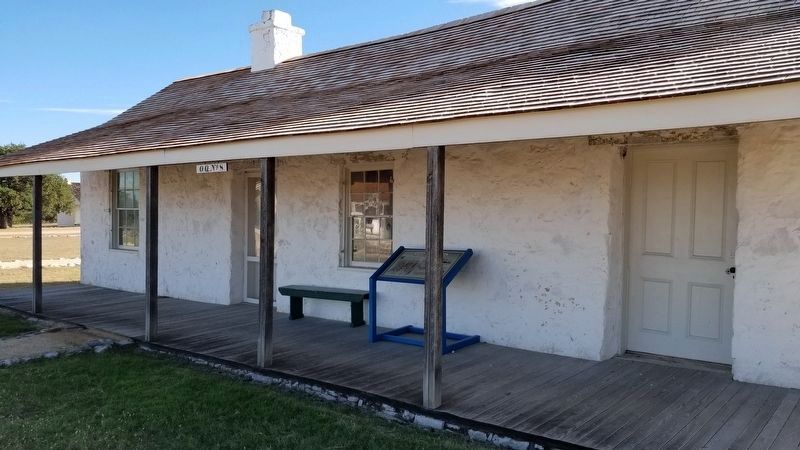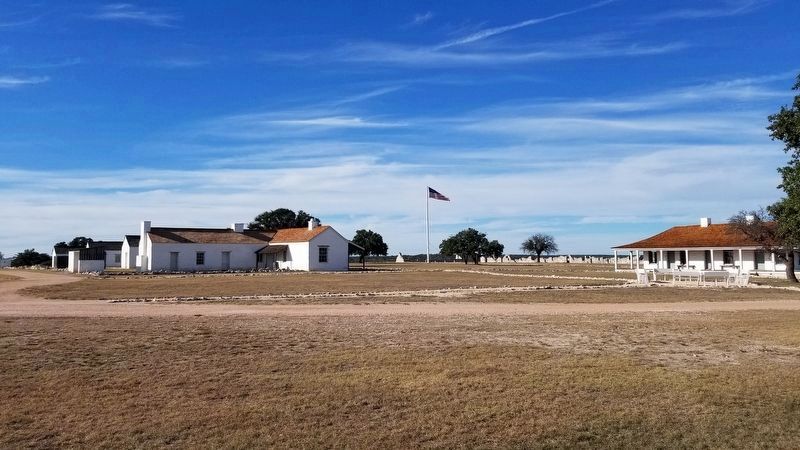Fort McKavett in Menard County, Texas — The American South (West South Central)
Cramped Quarters
Lower-ranking commissioned officers and their families lived in the row of houses in front of you. Although preferable to the barracks of the enlisted men, officers still had to share each of these small homes with as many as 10 other people.
Rank is Everything
Military rank determined everything about where and how soldiers lived, including amount of living space and total weight of belongings allowed. Look in the windows of the house closest to you to see where a married 2nd Lieutenant with a wife, child and servant are living in two rooms, while an unmarried 1st Lieutenant and his servant have a full three rooms. Is their furniture heavy or light?
Fancy Deadly Foods
Officers didn't eat in the mess halls with the enlisted men; they bought their own food and had servants prepare it. As wealthy regulars at the trader's store, they had more access to fancy canned foods. Unfortunately for them, 1870s manufacturers sealed cans with lead and preserved canned meats with formaldehyde. A potent neurotoxin, lead has been linked to schizophrenia, while ingestion of formaldehyde can lead to blindness, coma and death.
Bring Your Wife & Kids but ...
Only officers were allowed to bring their wives and children with them, but Army rules at the time discouraged it. Since living space was based on rank, whole families could be scrunched into one or two rooms or "ranked out" at any time, forcing them to move at a moment's notice when a higher-ranking officer came to the fort.
Captions
Second Lieutenants Robert Irvine and Leighton Finley relax in their shared quarters at Fort Leavenworth, Kansas in the late 1870s.
This servant in the kitchen of an officer's quarters was probably a European immigrant.
A popular saying, "If the Army had wanted you to have a wife, they would have issued you one. rings true. Army rules discouraged officers' wives, like the ones pictured here, from following their husbands to the frontier.
Erected by Fort McKavett State Historical Park.
Topics. This historical marker is listed in these topic lists: Forts and Castles • Wars, US Indian.
Location. 30° 49.599′ N, 100° 6.474′ W. Marker is in Fort McKavett, Texas, in Menard County. Marker can be reached from the intersection of Farm to Market Road 864 and Ranch to Market Road 1674. The marker is located in the central section of the Fort McKavett State Historical Park. Touch for map. Marker is at or near this postal address: 7066 FM 864, Fort Mc Kavett TX 76841, United States of America. Touch for directions.
Other nearby markers. At least 5 other markers are within 2 miles of this marker, measured as the crow flies. Home on the Range (within shouting distance of this marker); The Enlisted Men (about 300 feet away, measured in a direct line); Buffalo Soldiers at Fort McKavett (about 400 feet away); Site of Fort McKavett (approx. 0.2 miles away); Colonel Black Ranch House (approx. 1.4 miles away).
Also see . . . Fort McKavett.
Fort McKavett, twenty-two miles southwest of Menard in southwestern Menard County, was established by the United States War Department as Camp San Saba (not to be confused with Camp San Saba in McCulloch County) in March 1852. The camp covered about 2,373 acres near the right bank of the San Saba River. Several infantry companies were stationed there in an effort to protect frontier settlers from Comanche Indians. The post was abandoned in March 1859 but reoccupied in April 1868 under the name Fort McKavett. The new name was probably chosen in honor of Capt. Henry McKavett, who was killed in the battle of Monterrey in 1846. Source: The Handbook of Texas(Submitted on June 24, 2021, by James Hulse of Medina, Texas.)
Credits. This page was last revised on June 26, 2021. It was originally submitted on June 24, 2021, by James Hulse of Medina, Texas. This page has been viewed 148 times since then and 14 times this year. Photos: 1, 2, 3, 4. submitted on June 25, 2021, by James Hulse of Medina, Texas.



